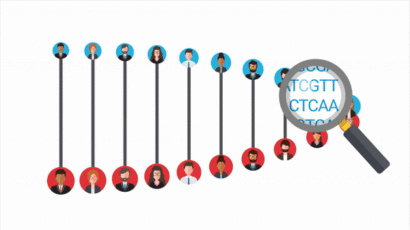An obscure emission from wildfire—black carbon—is accelerating snowmelt
By Matt Simon | May 24, 2024
 Image courtesy of Chil Vera/Pixabay
Image courtesy of Chil Vera/Pixabay
Editor’s note: This story was originally published by Wired. It appears here as part of the Climate Desk collaboration.
Once again, vast expanses of Canadian wilderness are on fire, threatening towns and forcing thousands to flee. It appears to be a breakout of “zombie fires”: wildfires from last year that never actually went out completely but carried on smoldering underground, reigniting ground vegetation again this year. They’ve been pouring smoke—once again—into northern cities in the United States. That haze is loaded with a more obscure form of carbon, compared to its famous cousin carbon dioxide: black carbon. By May 16, the fires’ monthly carbon emissions surpassed 15 megatons, soaring above previous years.
Black carbon consists of tiny particles generated from the incomplete combustion of fuels—whether that’s Canadian trees and soils, cooking fuels like wood and charcoal, or coal. “The problem is they don’t burn efficiently,” says Yusuf Jameel, who researches black carbon at the climate solutions nonprofit Project Drawdown. “They don’t combust properly. So they emit a lot of particles and poisonous gases.”
In a home in an economically developing nation which might use a wood stove for cooking, that can lead to catastrophic indoor air quality and all kinds of health consequences, including heart problems, breathing difficulty, and cancer. If black carbon wafts in from such wildfires in the Arctic, it darkens ice and snow, dramatically accelerating melt. “It’s a huge health issue. It’s a big climate issue,” says Jameel. “And yet, it barely receives any mention when we talk about a powerful climate solution.”
Carbon dioxdieand methane (CH4) get all the attention as planet-warming gases. And rightfully so: Humanity has to massively cut its emissions as fast as possible to slow climate change. At the same time, we’re neglecting easy ways to reduce emissions of black carbon.
While not a greenhouse gas like carbon dioxide and methane, black carbon has its own significant impacts on the climate. Clouds of dark wildfire smoke, for instance, absorb the sun’s energy, warming the atmosphere. While carbon dioxdie stays up there for centuries, and methane for a decade or so, black carbon falls back to Earth after no more than a few weeks.
That short lifespan is fortunate, atmospherically speaking, but unfortunate for the Arctic and other frigid places where black carbon lands. Usually snow and ice can persist because they’re so reflective, bouncing the sun’s energy back into space. But if they’re dusted with black carbon, the dark coloration absorbs heat. “You can see these little particles drilling holes down into the ice. It’s just very dramatic how the black carbon can absorb sunlight and heat things up,” says Brenda Ekwurzel, director of scientific excellence at the Union of Concerned Scientists. And if you fully melt the highly reflective snow or ice, she says, you uncover darker ground or ocean underneath, which absorbs sunlight much more readily, helping to heat up the region.
This then forms a feedback loop. As the world warms, wildfires in northern latitudes get ever more frequent and intense, as hotter temperatures suck out what moisture remains in the vegetation. Warming also provides more sources of ignition for these fires by encouraging thunderstorms: Modeling shows that lightning strikes across the Arctic could double by the end of the century. Wildfires have gotten so intense that they’re even spawning their own thunderclouds made of smoke, which roam across the landscape sparking new fires.
“We’re just seeing more and more fires in high latitudes,” says Brendan Rogers, who studies boreal forests and the Arctic at the Woodwell Climate Research Center in Massachusetts. “Fire has been a natural part of these ecosystems for thousands and thousands of years. The problem is that we’re seeing climate-warming-induced intensification of fires well above sort of historical norms, or even what we’ve seen in the paleo-record,” he says. Clues found in fossils, tree rings, ice sheets, and other long-lasting materials suggest we’re entering the climatic unknown.
Bigger, more intense, and more frequent fires produce more smoke and black carbon, which warms the atmosphere still more, further intensifying the blazes. (Arctic wildfires also release extraordinary amounts of carbon dioxdie, providing additional warming globally.) The black carbon that makes it to the Arctic—which is already warming up to four times faster than the rest of the planet—melts more snow and ice, leading to more local warming, and more melting, and more warming, and on and on. As sea ice disappears, it opens up the Arctic to more shipping, which spews yet more black carbon from the combustion of fuels.
While there’s no way to stop northern fires entirely, there are ways to prevent them. In places inhabited by humans, power lines are notoriously prone to sparking fires, so burying them underground would help, though at a significant cost. And generally, it would help to return to Indigenous strategies, like doing more controlled burns of land to clear out built-up fuels that can turn to tinder with a single spark. “You can put fire in the landscape when and where you want it, and avoid it when and where you don’t want it,” says Rogers. Smaller fires gently reset the ecosystem—as nature always intended—instead of obliterating it, so you get less production of black carbon.
Fortunately, there’s much more we can do about the black carbon that humans are directly spewing into the atmosphere. A major source here is unclean cooking fuels like wood and charcoal, particularly in India, China, and sub-Saharan Africa. Less-polluting fossil fuels, such as liquefied petroleum gas, could act as transition fuels, but the eventual ideal would be electrification, or solar-powered devices that focus the sun’s light to cook food. “Clean cooking has to be a very powerful emergency-brake solution,” says Jameel. “The World Bank estimates about $10 billion per year is needed to fund cooking solutions, so that everyone by 2030 has access to some form of improved cooking fuel, yet the funding is 10 times lower.” The health and environmental costs of inaction would be $2.4 trillion annually, the World Bank adds.
The other major sources of black carbon are heavy industries burning coal and the transportation sector—think of the black clouds spewing out the back of old buses. So the uniting factor here is fossil fuels: Decarbonizing our economy as rapidly as possible will stop emissions of greenhouse gases and black carbon, simultaneously improving public health. By reducing global temperatures, we’ll keep wildfires from getting even worse and jettisoning ever more black carbon into the Arctic, hastening its rapid decline. “Climate change is the ultimate driver of this,” says Ekwurzel. “So that needs to be the first-and-foremost solution: fossil fuel reductions.”

Together, we make the world safer.
The Bulletin elevates expert voices above the noise. But as an independent nonprofit organization, our operations depend on the support of readers like you. Help us continue to deliver quality journalism that holds leaders accountable. Your support of our work at any level is important. In return, we promise our coverage will be understandable, influential, vigilant, solution-oriented, and fair-minded. Together we can make a difference.
Keywords: black carbon, climate change, climate crisis, wildfire, zombie fire
Topics: Climate Change














